ASRock Z97 Extreme6 Review: Ultra M.2 x4 Tested With XP941
by Ian Cutress on May 24, 2014 12:00 PM ESTScientific and Synthetic Benchmarks
2D to 3D Rendering –Agisoft PhotoScan v1.0: link
Agisoft Photoscan creates 3D models from 2D images, a process which is very computationally expensive. The algorithm is split into four distinct phases, and different phases of the model reconstruction require either fast memory, fast IPC, more cores, or even OpenCL compute devices to hand. Agisoft supplied us with a special version of the software to script the process, where we take 50 images of a stately home and convert it into a medium quality model. This benchmark typically takes around 15-20 minutes on a high end PC on the CPU alone, with GPUs reducing the time.
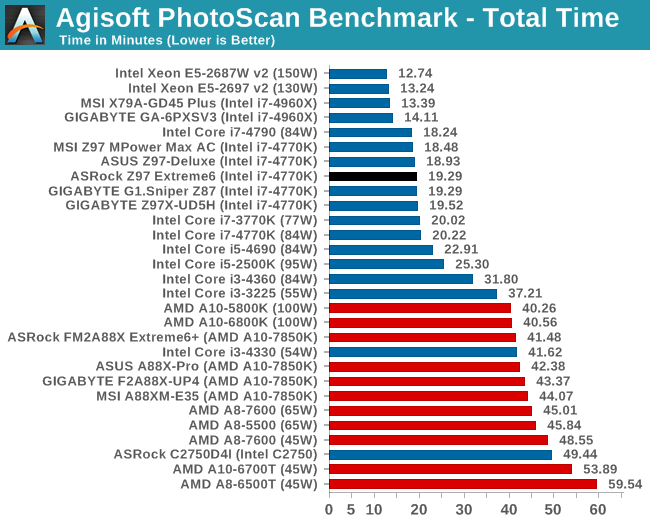
Console Emulation –Dolphin Benchmark: link
At the start of 2014 I was emailed with a link to a new emulation benchmark based on the Dolphin Emulator. The issue with emulators tends to be two-fold: game licensing and raw CPU power required for the emulation. As a result, many emulators are often bound by single thread CPU performance, and general reports tended to suggest that Haswell provided a significant boost to emulator performance. This benchmark runs a Wii program that raytraces a complex 3D scene inside the Dolphin Wii emulator. Performance on this benchmark is a good proxy of the speed of Dolphin CPU emulation, which is an intensive single core task using most aspects of a CPU. Results are given in minutes, where the Wii itself scores 17.53; meaning that anything faster than this is faster than an actual Wii for processing Wii code, albeit emulated.
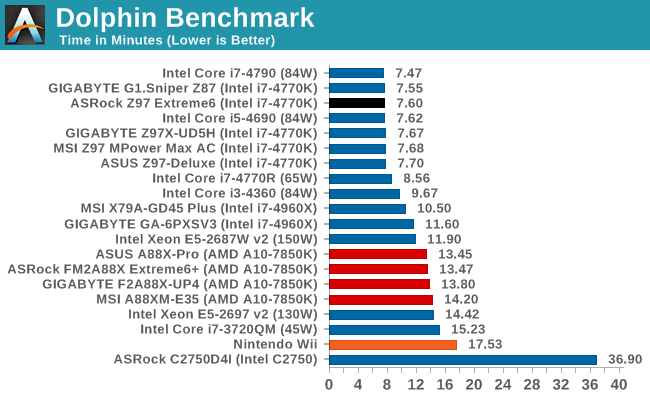
Point Calculations – 3D Movement Algorithm Test: link
3DPM is a self-penned benchmark, taking basic 3D movement algorithms used in Brownian Motion simulations and testing them for speed. High floating point performance, MHz and IPC wins in the single thread version, whereas the multithread version has to handle the threads and loves more cores.
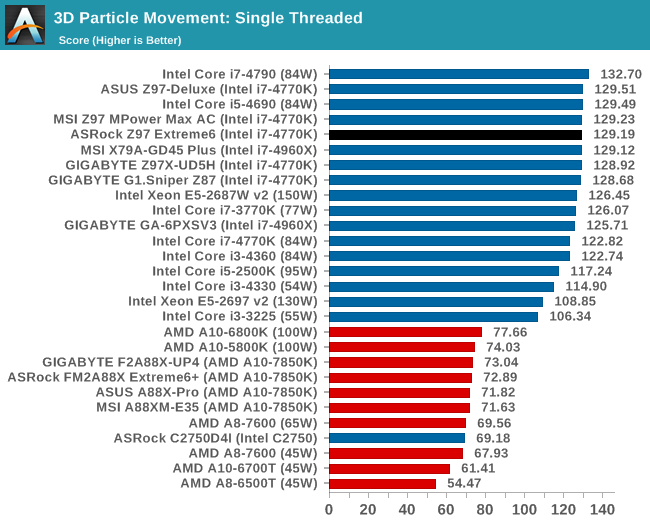
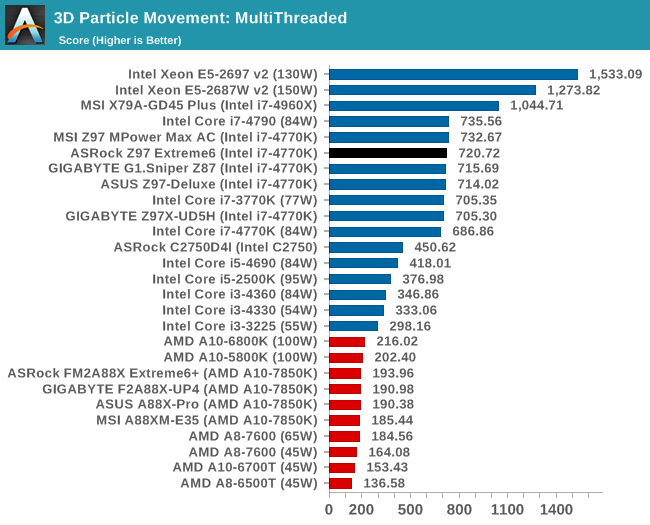
Encryption –TrueCrypt v0.7.1a: link
TrueCrypt is an off the shelf open source encryption tool for files and folders. For our test we run the benchmark mode using a 1GB buffer and take the mean result from AES encryption.
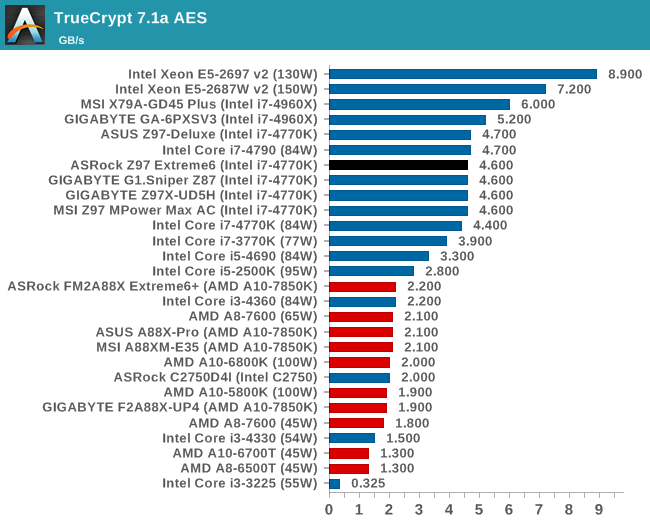
Synthetic – 7-Zip 9.2: link
As an open source compression tool, 7-Zip is a popular tool for making sets of files easier to handle and transfer. The software offers up its own benchmark, to which we report the result.
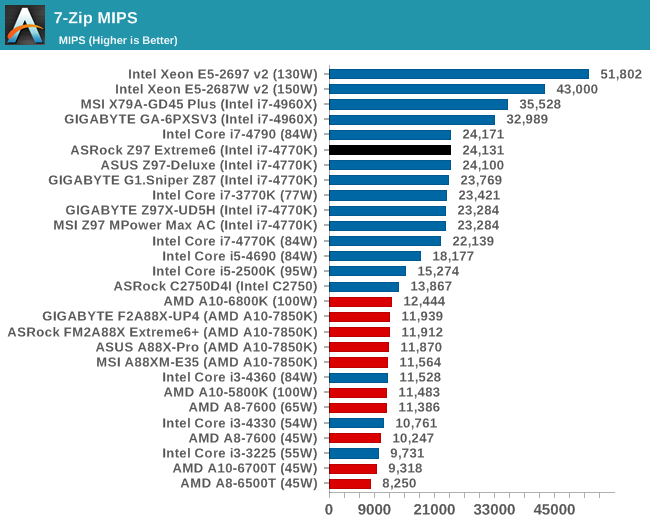










43 Comments
View All Comments
peterfares - Saturday, May 24, 2014 - link
It was stated in the article, using 4 lanes for M.2 from the chipset would leave too little lanes left for controllers and other onboard peripheral devices.SirKnobsworth - Sunday, May 25, 2014 - link
The chipset allows up to 8 PCIe lanes. Maybe having 8 USB 3 ports and 10 SATA ports matters for some, but certainly not everyone. If you use 4 lanes for M.2 you can still have 4 additional lanes going to the NIC/x1 slots/whatever, 4 USB 3.0 ports, and 6 SATA ports, noting that FlexIO allows some flexibility in that arrangement.Galatian - Sunday, May 25, 2014 - link
This! Thousand times this! I mean at least give the option. My PC if only a gaming machine. I have one SSD inside, one mouse, one keyboard and one XBox Controller receiver. I have no need for more ports. At least give me some option: as I said it's either this extreme or the other extreme, but nothing in between.isa - Sunday, May 25, 2014 - link
But the article also said a reason was m.2 cards would mostly or only be offered in 2 channel flavors, and that makes no sense to me since I believe the z97 chipset supports 4 channels of PCIe 2.0 for m.2. I agree many would want 4 channels even if meant sacrificing a few usb ports or whatever, so I'd think the market would provide 4 channel m.2 cards to support those customers.Luke_Higdon - Sunday, April 10, 2016 - link
Question: "Can you explain to me why no mainboard manufacturer is using 4 lanes from the chipsets PCIe 2.0? I mean that would be enough for the Samsung SSD and still has room left."Answer: No It would run at a third the speed.
Question: I mean what do I gain from all those SATA and USB ports? Who is actually using all of them?
Answer: Lots of people including me. I have 6 hard drives a CD player. Plus they are very cheap to make so if you buy an upgraded motherboard this is the least they could do. I understand most people don't need all of that but that is why you would buy a cheaper Motherboard. However most people have 2 hard drives and a DVD player and it is used for adapters and if you are doing RAID it could need double the amount of SATA ports or triple.
Statement: Right now I have to choose between either a slow M.2 slot because they only allocate 2 lanes or I can go with ASRock which feels like overkill and takes away CPU PCIe lanes.
Answer: ASrock doesn't take away PCIe lanes. CPU's are given a fixed amount of PCIe lanes typically 16. If you have a video card it takes 8 and you are left with 8 in which 4 are taken from the 950 pro. If you dont play video games and use integrated graphics from a motherboard then you can buy any motherboard that uses 3.0 PCIe for at least one slot which is most of them.
Marlowe - Saturday, May 24, 2014 - link
All new motherboards should have pcie x4 m.2 slots to be worthwile.. There are really no excuse not to. The x2 version is a too small upgrade from old SATA. Anyone who buys a new fast pcie ssd will need x4 to fully utilize it.I think you can install both Win 7 and Win 8 in UEFI mode.
SirKnobsworth - Sunday, May 25, 2014 - link
A few thoughts:- The SSD only supports PCIe 2.0, not 3.0, so the maximum theoretical bandwidth is 20 rather than 32 gbps. The actual performance is still far below that too though. To my knowledge there are not PCIe SSDs currently available that support gen 3, though I think OCZ will be shipping 2.0x8 SSDs soon.
- Leaked roadmaps show that Intel will be increasing the number of PCIe lanes on the chipset rather than the processor - the chipsets accompanying Skylake should have 20 PCIe 3.0 lanes. If you want more lanes directly from the CPU then there's already an option - Intel's LGA2011 Enthusiast options have 40 PCIe 3.0 lanes from the CPU.
ShieTar - Monday, May 26, 2014 - link
Also, if the x2 port maxes out at 765 MBps of just below 6 Gbps, than we probably should not expect more than roughly 12 Gbps from the x4 port either. So the XP941 would be significantly closer to the interface maximum than the article suggests.Laststop311 - Thursday, May 29, 2014 - link
A lot of people want to build mini itx form factor. LGA 2011 doesn;t exist and never will it's physically too large a socket. All the people like me have a great need for increased pci-e lanes from the cpu. Controllers degrade performance and add latency.At the same time for mini itx you can only fit one pci-e slot on there but it would be nice if we could keep it at 16x for when gpu's do start needing the extra bandwidth and still have 8x left over for 2 4x m2 slots. 24x pci-e 3.0 cpu lanes needs to be on their mainstream. That still leaves a whole 16x gap to the enthusiast and they can increase those by 8 too to 48 lanes and keep the separation the same. Then everyone can be happy.
romrunning - Thursday, May 29, 2014 - link
I will add my vote to wanting a mini-ITX board. To me, I really don't know anyone who is actually using 3 PCIe slots. However, I do know quite a few who are tired of the big towers.Also, where are these people who want a ton of SATA slots in a home PC?? The only chassis I know where I want that many ports is in a server, and there I'm getting space for 16-24 drives - not this Frankenstein of 10 SATA slots. People at home who need a lot of space (for work or pleasure) are getting a NAS, not trying to load out a machine with 6-10 drives.
My picture of a great mini-ITX board - Z or H 9-series chipset, 4 x 6Gbps SATA ports supporting RAID 0/1/5/6, 2 x m.2 (x4) supporting RAID 0/1, no SATA Express (waste of space), 1x eSATA, 4-6 USB 3.0 ports, optional mSATA/PCIe slot for wireless add-on, and a single x16 PCIe 3.0 slot. Price it at $110-150, and I'd buy it in a heartbeat!